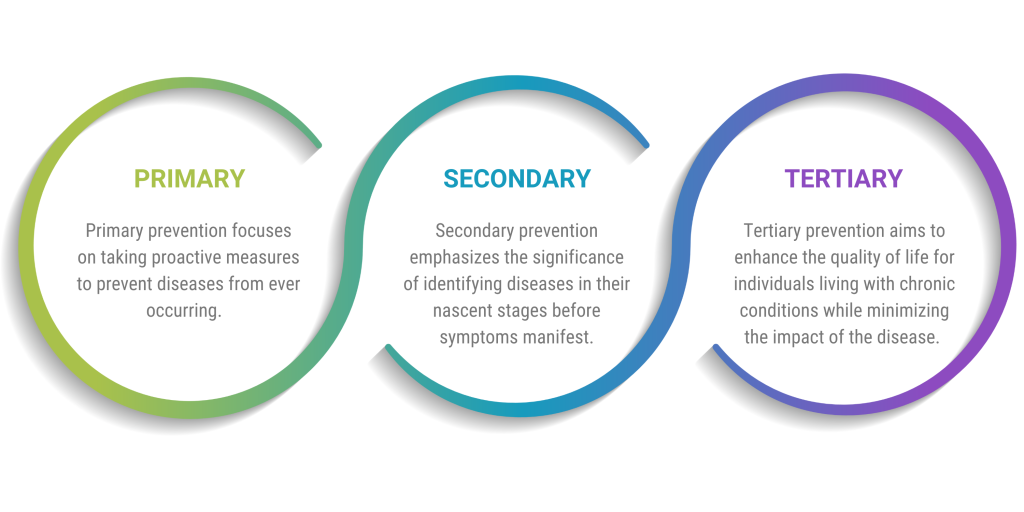How Wellness Programs Support the 3 Stages of Prevention

Wellness programs, at their core, focus on the adoption and maintenance of healthy behaviors. Adopting a strategy focusing on prevention has a major impact on the success of a wellness program. The Centers for Disease Control and Prevention (CDC) categorizes prevention activities into three stages: Primary, Secondary, and Tertiary. By addressing health concerns at each stage, these programs contribute significantly to enhancing overall well-being and reducing the burden of disease.
Building a Solid Foundation: Primary Prevention
Primary prevention focuses on taking proactive measures to prevent diseases from ever occurring. Here are some ways wellness programs address primary prevention:
Help Participants Understand Where They Need to Make Changes to Their Health
Employees are encouraged to complete a health risk assessment (HRA) so that they get an overview of their health status, identify risk lifestyle behaviors, and detect future disease risks such as hypertension or diabetes.
Change Bad Habits and High-Risk Behaviors
Facilitating behavior change through developing healthy habits can play a significant role in primary prevention. The responses and readiness to change data collected as part of the HRA are particularly useful for targeting resources and identifying primary candidates who would benefit from counseling to effectively change high-risk behavior.
Additionally, wellness challenges and trackers play a pivotal role in transforming unhealthy habits within a comprehensive wellness program. These tools offer a structured framework for individuals to set and monitor achievable goals, fostering a sense of accountability and motivation. By actively participating in challenges, such as step counts or dietary adjustments, and tracking their progress through digital platforms or apps, participants gain valuable insights into their behaviors. This data-driven approach allows them to identify patterns, acknowledge areas for improvement, and celebrate milestones, ultimately motivating positive change. Through continuous engagement with challenges and trackers, individuals can gradually replace detrimental habits with healthier alternatives, leading to long-term well-being and lifestyle improvements.
Promote Vaccinations
Vaccinations such as flu shots and COVID-19 vaccinations boost immunity and prevent the spread of illnesses in the workplace. Wellness programs provide a way for employees to promote the benefits of receiving a vaccination, track completion, and make recommendations based on age and gender.
Catching it Early: Secondary Prevention
The essence of secondary prevention lies in early detection. This stage emphasizes the significance of identifying diseases in their nascent stages before symptoms manifest. By doing so, individuals gain the advantage of timely intervention, which can drastically improve treatment outcomes and prognosis. Here are some ways wellness programs address secondary prevention:
Emphasize the Importance of Primary Care
A relationship with a primary care provider (PCP) can help employees detect and manage a wide range of health issues. In fact, the 2023 National Alliance Immunization Prevention Survey Results highlight the critical role of primary care in boosting immunization rates. A significant 95% of respondents acknowledged the centrality of primary care in these efforts. Many wellness programs will encourage every employee to have a PCP and participate in an annual physical as a key requirement. It is beneficial and less costly for the insurer to pay for primary care rather than an unnecessary specialty or emergency room visit. Many large employers address this issue by allowing access to primary care through an onsite clinic. Being able to connect with a PCP virtually using telehealth should improve care access.
Require Attendance at an Annual Biometric Screening
Biometric screenings are typically offered as part of a company-sponsored wellness program. Screenings that include point of care testing, provides immediate results and feedback. This type of immediate feedback is a call to action and a great segway to primary care or to see a specialist.
Encourage Regular Preventive Screenings & Exams
Preventive screenings such as dental and eye exams, mammograms, and cancer screenings can lead to early detection. Many wellness programs will personalize recommended screenings based on the individual’s claims data, age, and gender. The wellness portal is a great way to provide helpful links to resources about each screening and track completion.
Make At-Home Test Kits Easy & Affordable
Participants may be more likely to take an at-home test kit than visit their doctor. To accommodate this preference, more and more employers are providing a convenient way for individuals to order at-home test kits that are fully covered or offered at discounted prices to find or screen for lipids and glucose, genetic disorders, infectious diseases, and more. This may allow the individual to get treatment earlier and avoid serious complications. Some test kit providers will even integrate into the employer’s wellness portal for a streamlined ordering process.
Managing Health Post-Diagnosis: Tertiary Prevention
When health conditions are diagnosed, the focus shifts to managing the disease and preventing further progression. Tertiary prevention aims to enhance the quality of life for individuals living with chronic conditions while minimizing the impact of the disease. Here are some ways wellness programs address tertiary prevention:
Connect Individuals with a Health Coach or Care Manager
Health coaches provide employees with guidance, support, and strategies for managing chronic conditions. Care managers can assist in a comprehensive approach by coordinating medical appointments, treatments, and lifestyle modifications.
Personalize Disease Management Programs
Offering structured programs for disease management, such as those focused on diabetes, heart disease, or chronic pain, equips individuals with tools to manage their conditions effectively. Many organizations will use data from the health assessment to identify and qualify individuals for eligibility into these programs and drive recommendations.
Offer Self-Management Tools
Supplying individuals with self-management tools, such as apps or online platforms that provide personalized interventions, helps them monitor their conditions, adhere to treatment plans, and track symptoms, medications, and lifestyle changes.
Encourage Action Across All Stages
Motivate Through Incentives
Rewards are commonly used in wellness programs to encourage employees to take healthy action. Many programs will incentivize employees for participation or completion of activities. The reward can vary by organization to include gift cards, merchandise, and even monetary rewards.
Target Communication
Program administrators can educate participants on preventive measures and inspire them to make informed choices about their health by sending clear communication throughout the program. Successful communication strategies factor in:
- Distinctive Marketing Campaigns: Implement campaigns that emphasize the protective nature of preventative efforts and their contribution to personal and communal health.
- Multilayered reinforcement: Combine various techniques and strategies to reinforce a message across different levels. This may include utilizing social media, hosting educational workshops, and organizing community events. These methods collectively contribute to a comprehensive and widespread outreach effort.
- Simplicity: Enhance comprehension and motivation through clear and straightforward communication. The outcome is a better understanding of the benefits of prevention and an increased likelihood of active participation in these crucial initiatives.
Summary

Successful wellness programs have a strong focus on prevention. It is very important to understand the difference between primary, secondary, and tertiary prevention to develop strategies to optimize the participation for each type of prevention. Prevention is the best outcome of a wellness program as this improves the health and productivity of employees and eliminates the healthcare costs associated with chronic diseases. An annual HRA combined with a biometrics screening provides ongoing surveillance of health and chronic conditions. This information is used to track progress and to adjust programming to better manage population health changes within an organization.

